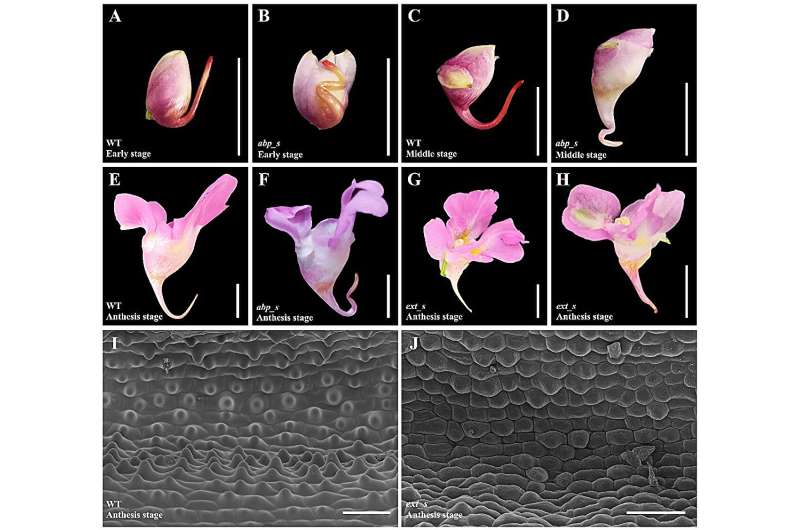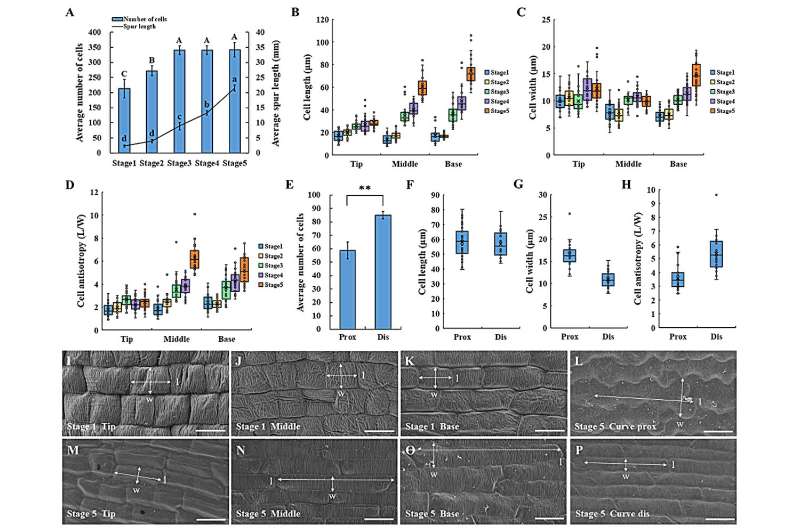This article has been reviewed according to Science X's editorial process and policies. Editors have highlighted the following attributes while ensuring the content's credibility:
fact-checked
trusted source
proofread
Research team reveals cellular and molecular basis of spur development in Impatiens uliginosa

As an important reproductive organ of angiosperms, flowers have a clear purpose and adaptive significance in their various characteristics. As a typical floral evolutionary feature, the floral spur is a tubular structure extending from the petal, which has undergone several independent evolutions in angiosperms (e.g., Impatiens, Aquilegia, Linaria, etc.).
It plays a vital role in the pollination process because of its properties of secreting and storing nectar. In addition, the morphology (length, diameter, degree of distortion), color, and internal structure of spur exhibit a wide range of species diversity.
In the process of interacting with pollinators, spur improves pollination efficiency and ecological adaptability through the evolution of characteristics such as length and curvature. Plant lineages with spur often exhibit astonishing species diversity and faster species formation rates, so spur is considered a key innovation and has been the focus of numerous studies such as evolution and ecological hypotheses.
The study on the spur development process and the mechanism is helpful to further understand the species diversity and evolutionary mechanism of plant lineages. However, research on spur development has only been conducted in a few species, and its mechanism is not yet clear, showing significant species differences.
In January 2024, Horticulture Research published research titled "The cellular and molecular basis of the spur development in Impatiens uliginosa."
In this study, Impatiens uliginosa was used to analyze the characteristics and rules of spur development from the perspectives of morphology, histocytology, physiology and molecular biology. The spur development in I. uliginosa is composed of early cell division and later anisotropic cell elongation.

During the entire development process, there were two imbalanced cell division events on the inner and outer sides of the spur, which respectively led to the unique upward growth of the spur in the early stage and the formation of spur curve in the middle stage. In addition, substances such as auxin, gibberellin, and jasmonic acid exhibit significant differences in different parts and stages of spur development, indicating that hormones are involved in regulating spur development.
The regulation of IuABP and IuEXT genes on spur development was clarified by using RNA-seq and transient expression system in I. uliginosa. The downregulation of IuABP in spur leads to an increase in the number of spur curves and morphological distortion, suggesting that it may regulate cell division or elongation at different stages through the mediation of auxin action, and coordinate the transition between them.
The downregulation of IuEXT significantly shortened the spur length by inhibiting cell elongation, leading to the disappearance of spur curve and the inner epidermal papillae.
This study provides new insights into the cellular and molecular mechanisms of spur development in angiosperms.
More information: Yang Li et al, The cellular and molecular basis of the spur development in Impatiens uliginosa, Horticulture Research (2024). DOI: 10.1093/hr/uhae015
Provided by NanJing Agricultural University





















